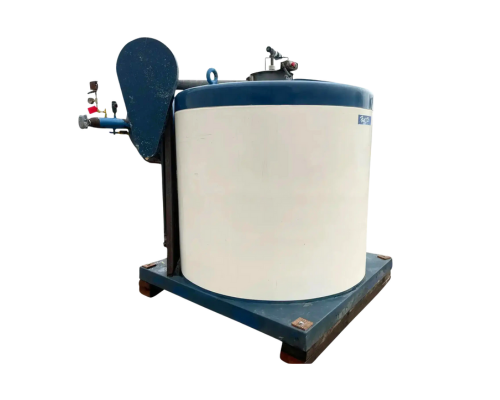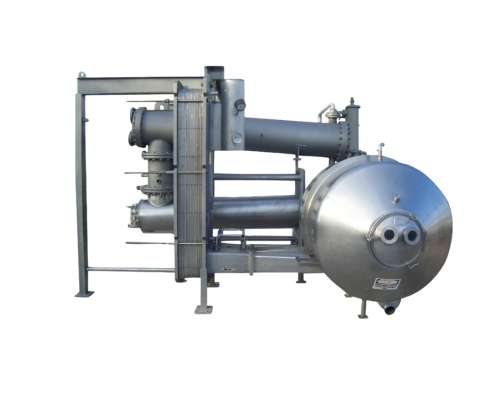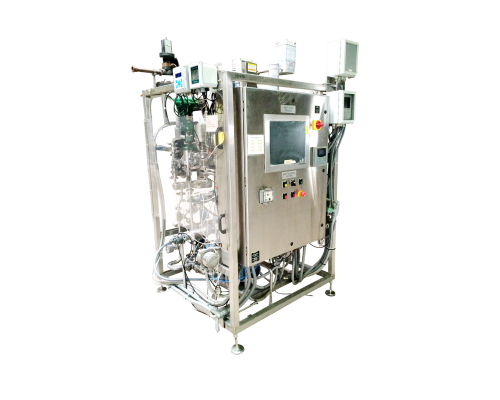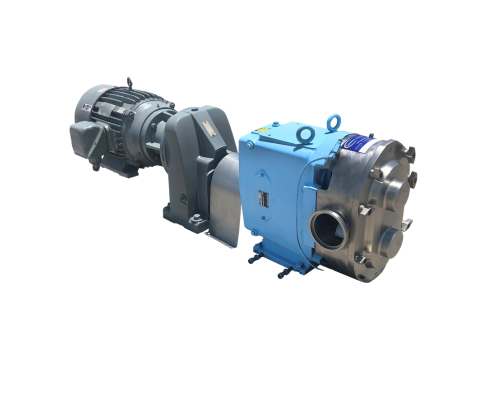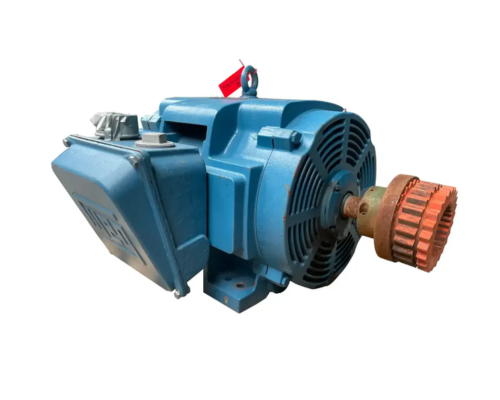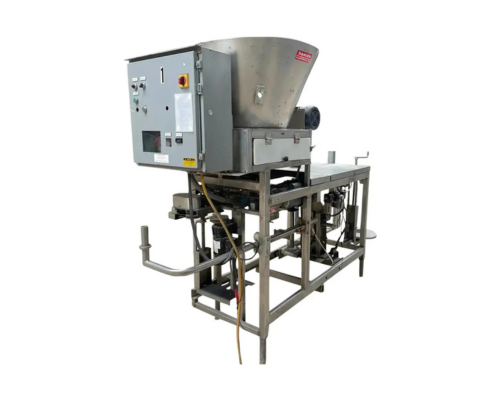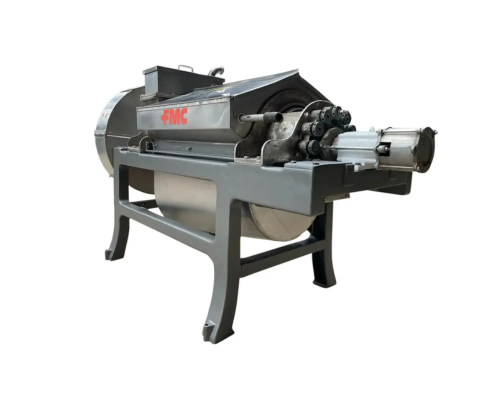El sector de generación de energía es uno de los que más energía consume y requiere sistemas de refrigeración robustos para gestionar el calor significativo que se genera durante la producción de electricidad. Los condensadores refrigerados por aire (ACC) industriales se han convertido en un componente fundamental en las centrales eléctricas, en particular porque la escasez de agua y las preocupaciones ambientales impulsan la necesidad de soluciones de refrigeración más sostenibles y eficientes en el uso del agua. En este artículo, exploraremos las diversas aplicaciones de los condensadores refrigerados por aire en la generación de energía y las ventajas que ofrecen.
Imagen de Genemco
Enlace a condensadores enfriados por aire

Aplicaciones clave en el sector de generación de energía
1. Centrales térmicas de vapor
En las centrales eléctricas de vapor, el vapor generado por la quema de carbón, gas natural u otros combustibles impulsa turbinas para producir electricidad. Después de pasar por la turbina, el vapor debe condensarse nuevamente en agua antes de reciclarse en la caldera. Para lograr esta condensación sin necesidad de grandes cantidades de agua de refrigeración, se utilizan condensadores enfriados por aire.
-
Cómo se utilizan :
- Condensar directamente el vapor de escape de la turbina, convirtiéndolo nuevamente en agua para reutilizarlo en el ciclo de agua de alimentación de la caldera.
- Se instala como alternativa a los sistemas tradicionales refrigerados por agua, como torres de enfriamiento y condensadores de superficie.
- Se utilizan a menudo en centrales eléctricas de ciclo combinado (CCPP), donde condensan el vapor del generador de vapor de recuperación de calor (HRSG).
-
Beneficios :
- Conservación de agua : los ACC eliminan la necesidad de agua de refrigeración, lo que los hace ideales para regiones áridas o áreas con recursos hídricos limitados.
- Menor impacto ambiental : Reduce la contaminación térmica eliminando la descarga de agua caliente en ríos o lagos.
2. Centrales eléctricas de ciclo combinado (CCPP)
Las centrales eléctricas de ciclo combinado utilizan turbinas de gas y de vapor para producir electricidad, lo que mejora la eficiencia. Estas plantas generan vapor a partir del calor residual de las turbinas de gas, que luego se utiliza para impulsar una turbina de vapor. Los condensadores enfriados por aire desempeñan un papel crucial en la condensación del vapor después de que pasa por la turbina de vapor.
-
Cómo se utilizan :
- Condensar el vapor que sale de la turbina de vapor, mejorando la eficiencia general de la planta al maximizar la recuperación de calor.
- Integrado con generadores de vapor de recuperación de calor (HRSG) para optimizar el proceso de enfriamiento.
- Permite el enfriamiento en seco, lo que es particularmente beneficioso en regiones con regulaciones estrictas sobre el uso del agua.
-
Beneficios :
- Mayor eficiencia : mejora la eficiencia de las operaciones de ciclo combinado al proporcionar un enfriamiento efectivo para el ciclo de vapor.
- Costos operativos reducidos : disminuye la dependencia del agua y reduce los costos asociados con el tratamiento y descarga de agua.
3. Centrales nucleares
Las centrales nucleares requieren sistemas de refrigeración eficientes para gestionar el calor generado por los reactores nucleares. Si bien el agua se utiliza habitualmente para enfriar los reactores, los condensadores enfriados por aire proporcionan una opción de refrigeración adicional para el ciclo de vapor secundario, especialmente en lugares donde escasea el agua.
-
Cómo se utilizan :
- Se utiliza en el circuito de enfriamiento secundario para condensar el vapor de la turbina, lo que permite un sistema de circuito cerrado que conserva el agua.
- Servir como sistema de enfriamiento de respaldo o complementario para garantizar la seguridad de la planta en caso de escasez de agua o fallas en la torre de enfriamiento.
- Ayuda a enfriar el vapor generado por los sistemas auxiliares y generadores de energía de emergencia.
-
Beneficios :
- Seguridad mejorada : proporciona un método de enfriamiento alternativo, mejorando la resiliencia de la infraestructura de enfriamiento de la planta.
- Gestión de recursos hídricos : apoya operaciones sostenibles al reducir la demanda de agua de refrigeración en regiones sensibles.
4. Centrales eléctricas de energía renovable (geotérmica y solar térmica)
Las plantas de energía renovable, en particular las plantas de energía geotérmica y solar concentrada (CSP), generan una cantidad importante de calor que debe gestionarse de manera eficaz. Los condensadores enfriados por aire son una excelente opción para estas aplicaciones debido a su capacidad de funcionar de manera eficiente sin agua.
-
Cómo se utilizan :
- En las plantas geotérmicas, los ACC condensan el vapor extraído de depósitos subterráneos después de accionar la turbina.
- En las plantas de CSP, los ACC se utilizan para condensar el vapor generado por fluidos calentados con energía solar, lo que aumenta la eficiencia térmica de la planta.
- Permitir el enfriamiento seco para plantas de energía renovable, lo cual es crucial en lugares remotos y áridos donde el agua es escasa.
-
Beneficios :
- Sostenibilidad : Se alinea con los objetivos ambientales de los proyectos de energía renovable al minimizar el uso de agua.
- Flexibilidad de ubicación : permite que las plantas de energía se ubiquen en regiones donde los recursos hídricos son limitados, ampliando el potencial para proyectos de energía renovable.
Imagen de Genemco
Enlace a condensadores enfriados por aire 
5. Centrales eléctricas de máxima demanda y generadores de emergencia
Las centrales eléctricas que funcionan en horas punta, durante períodos de alta demanda de electricidad, y los generadores de respaldo requieren sistemas de refrigeración eficientes que puedan implementarse rápidamente. Los condensadores enfriados por aire ofrecen una solución confiable para estas aplicaciones.
-
Cómo se utilizan :
- Proporcionar enfriamiento rápido para turbinas de gas y motores alternativos en plantas de energía de máxima demanda, asegurando ciclos rápidos de arranque y apagado.
- Se utiliza en sistemas de energía de respaldo para centros de datos, hospitales y otras infraestructuras críticas para mantener la eficiencia de enfriamiento.
- Ayuda a controlar las temperaturas de los generadores de emergencia durante cortes de energía, reduciendo el riesgo de sobrecalentamiento.
-
Beneficios :
- Implementación rápida : el diseño compacto y modular permite una rápida instalación y escalabilidad, lo que los hace ideales para aplicaciones temporales o de emergencia.
- Costos operativos más bajos : Reduce la necesidad de sistemas de enfriamiento por agua, que pueden ser costosos de operar y mantener.
Ventajas de utilizar condensadores enfriados por aire en la generación de energía
-
Independencia del agua : una de las ventajas más importantes de los condensadores enfriados por aire es su capacidad de funcionar sin agua. Esta característica es particularmente beneficiosa para las centrales eléctricas ubicadas en regiones áridas, donde la escasez de agua es un problema crítico.
-
Reducción del impacto ambiental : al eliminar la necesidad de torres de enfriamiento y descarga de agua, los condensadores enfriados por aire minimizan la huella ambiental de las plantas de energía. Esto ayuda a reducir la contaminación térmica y cumple con las regulaciones ambientales más estrictas.
-
Menores costos operativos y de mantenimiento : los sistemas enfriados por aire requieren menos mantenimiento que los sistemas tradicionales enfriados por agua, que implican un tratamiento complejo del agua y son propensos a la formación de incrustaciones, corrosión y bioincrustaciones. Esto se traduce en menores costos operativos a largo plazo.
-
Flexibilidad y modularidad : el diseño compacto y modular de los condensadores enfriados por aire permite una fácil integración en plantas de energía existentes o en nuevos proyectos. Se pueden instalar en tejados, en áreas al aire libre o incluso modernizar para reemplazar sistemas enfriados por agua obsoletos.
-
Confiabilidad mejorada : construidos para soportar condiciones ambientales adversas, los condensadores enfriados por aire están diseñados para una alta durabilidad y un rendimiento a largo plazo, lo que garantiza un funcionamiento confiable incluso en temperaturas extremas.
-
Eficiencia energética : Al optimizar el proceso de condensación, los condensadores enfriados por aire mejoran la eficiencia general de las plantas de energía, particularmente en aplicaciones de ciclo combinado y energía renovable.
Los condensadores industriales refrigerados por aire están adquiriendo cada vez mayor importancia en el sector de generación de energía debido a su capacidad para proporcionar soluciones de refrigeración eficientes, sostenibles e independientes del agua. Desde plantas de energía a vapor y de ciclo combinado hasta proyectos de energía renovable e instalaciones nucleares, estos sistemas ofrecen opciones de refrigeración versátiles y rentables que se alinean con el impulso de la industria hacia la sostenibilidad y la conservación de los recursos. A medida que la escasez de agua y las regulaciones ambientales continúan impulsando el cambio en el sector energético, se espera que aumente la adopción de condensadores refrigerados por aire, lo que los convertirá en un componente vital de la infraestructura de generación de energía moderna.

